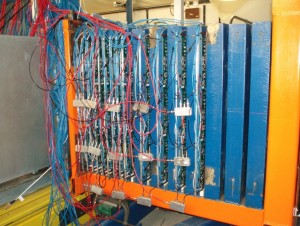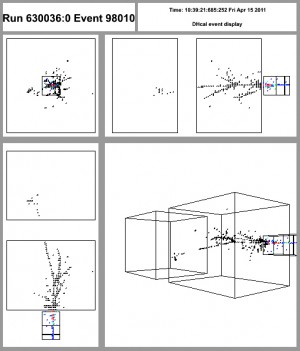
The Tail Catcher and Muon Tracker of the CALICE collaboration’s Digital Hadron Calorimeter. The absorber plates are thinner in the front (left of the picture) than in the back. Image: José Repond.
The CALICE collaboration’s calorimeter has grown a head and a tail.
The Digital Hadron Calorimeter, or DHCAL, has acquired new active layers since scientists first began testing it last year. The additional layers, positioned at both the front and back ends of the detector, allow scientists to form more complete pictures of particle showers.
“This detector now has more readout channels than the ATLAS or CMS calorimeters combined,” said Argonne National Laboratory’s José Repond, DHCAL spokesperson, referring to two of the detectors at CERN’s Large Hadron Collider. Where those giant detectors are two to three stories high, the full DHCAL detector is only a few cubic metres.
That meagre volume now contains 490,000 channels to help piece together images of particle paths in hadronic showers.
At the rear of DHCAL is the new Tail Catcher and Muon Tracker, or TCMT. The addition of this 130,000-channel section more than doubles the volume in which hadronic showers can be measured.
It captures the tail ends of pion-particle showers, which are often not completely contained in the original one-cubic metre detector. By adding the tail catcher’s 13 square-metre layers to the rear of the original setup, scientists can study the last bits of the tail of hadronic showers. The TCMT is especially needed considering the hadron showers’ erratic behaviour.

A recent event display of a 32-gigaelectronvolt pion in all three sections of the CALICE calorimeter, currently undergoing tests in the FTBF particle beam. The TCMT, the main section of the DHCAL, and the electromagnetic calorimeter are depicted from left to right in the top right section; the beam enters from the right. Red and blue dots indicate the energy deposited in the ECAL section. The pion shower develops in the DHCAL as shown by the black dots. Vestiges of the pion shower’s tail are seen in the TCMT as a few sparse dots. Top left: front view. Top right and bottom left: top views. Bottom right: Three-quarters view. Image courtesy of Daniel Jeans.
“Sometimes pions don’t do anything for the longest time,” Repond said, noting that the pions can plough through DHCAL’s iron layers without incident until reaching the very back of the detector. “Then they interact. Voom! A big explosion.” Without the TCMT bringing up the rear, in many cases the ‘big explosion’ would go undetected or only partly captured.
The ‘MT’ of the TCMT refers to the ‘muon tracker’ and indicates a second task of such a device in a colliding beam detector, the identification of muons. Muons tend to fly through large chunks of matter without ever interacting and so lose energy only very slowly, even when flying through dense iron absorbers. These unstoppable tracks are the signatures by which muons are in general identified.
The second, front-end addition is the electromagnetic calorimeter (ECAL), a 10,000-readout channel detector that measures the energy of photons and electrons incident on the detector. About the size of a microwave oven, this calorimeter contains tungsten plates and one-square-centimetre silicon pads. Its role is to measure electromagnetic showers and the beginning of hadronic showers.
The CALICE collaboration had already tested its ECAL in 2008 at the Fermilab Test Beam Facility, together with a completed version of the DHCAL calorimeter using scintillator pads as active elements.
Scientists finished adding the two sections in early April. As they continue to test and tweak the detector, they’ll ramp up the energies of the beams impinging on it.
Stay tuned to ILC NewsLine for future work on detector research.

Recent Comments